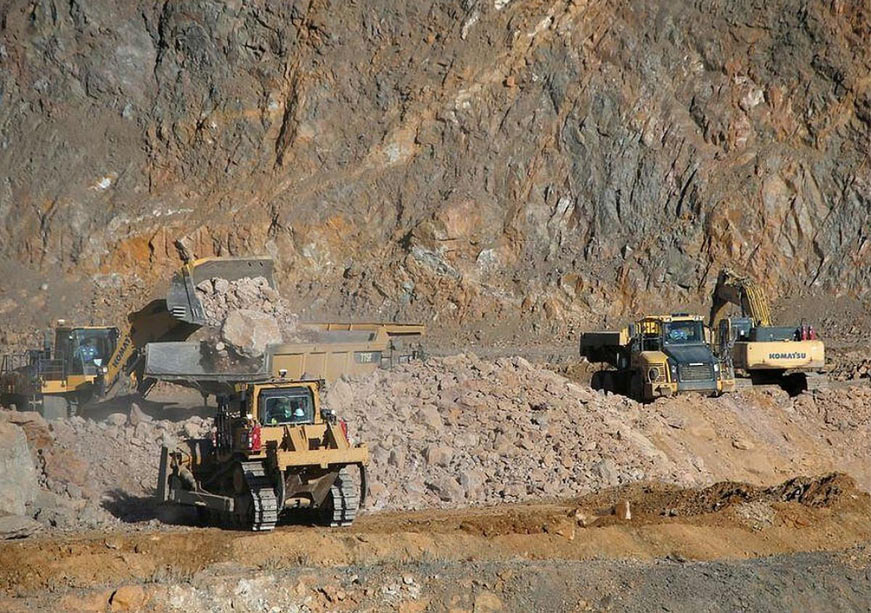-
CENTRES
Progammes & Centres
Location
The US–China rare-earth truce offers a brief opening. India, long exporting raw minerals, now has a chance to build processing power and strategic leverage.

In the intricate realm of global resource geopolitics, rare earth elements (REEs) are the silent sovereigns—ubiquitous in electric vehicles (EVs), wind turbines, semiconductors, and defence systems, yet perilously concentrated in a few hands. China commands over 69 percent of global REE mining and an overwhelming ~ 90–92 percent of refining capacity—an imbalance that has long cast a shadow over the world’s clean-energy transition and supply-chain resilience.
The recent United States (US)–China “truce” on rare earths, struck during President Donald Trump’s meeting with Xi Jinping on 30 October 2025 in Busan, South Korea, offers a fragile pause in an ongoing strategic rivalry. Beijing agreed to suspend its 9 October export controls on REEs and related materials for one year, while Washington halved its so-called “fentanyl tariffs” and froze a proposed 100 percent levy on Chinese goods. Trump hailed it as a “deal settled for the world,” with scope for annual renewals. Yet experts caution it is a tactical armistice, not a peace accord: earlier restrictions on seven REEs imposed by China in April 2025 remain intact, leaving Beijing’s leverage largely undiminished.
Rare earth elements (REEs) are the silent sovereigns—ubiquitous in electric vehicles (EVs), wind turbines, semiconductors, and defence systems, yet perilously concentrated in a few hands.
This temporary easing comes at a pivotal moment for India, which holds the world’s third-largest reserves of REEs—around 8 percent of global reserves—and yet contributes less than 1 percent of global REE mining output. India’s in-situ Rare Earth Oxide (REO) deposits—largely in monazite sands along the beach and alluvial terrains of coastal states such as Andhra Pradesh, Odisha, Tamil Nadu, and Kerala—are estimated at 7 million tonnes. Long an extractor exporting raw concentrates—India imported over 53,000 metric tonnes of REE magnets in FY 2024–25 alone. The country is now pivoting decisively toward processing sovereignty.
The government’s INR 34,300 crore incentive package under the National Critical Minerals Mission (NCMM), approved early this year and slated over seven years, signals this ambition. The mission envisions 1,200 domestic exploration projects by 2031, the acquisition of 50 overseas assets, and self-sufficiency in processing at least five key REEs. As Washington’s proposed HIRE Act—anticipated to impose a 25 percent tax on outsourcing from January 2026—threatens to disrupt India’s US$100 billion IT and semiconductor exports, this REE push becomes not merely an economic initiative but a strategic hedge for India’s green ambitions and leadership in the Global South.
China’s October controls, which extended even to trace REE content in finished devices, echoed its 2010 embargo on Japan and the 2023 gallium curbs—classic instances of resource weaponisation to extract diplomatic concessions. While the White House fact sheet mentioned “general licenses” for the US end-users, ambiguity persists around military-grade magnets critical for F-35 fighter jets and EV motors.
Global REE prices surged 15 percent following the announcement, which delayed India’s EV incentive rollout and semiconductor expansion under the US$10 billion Production Linked Incentive (PLI) scheme. For a nation that relies on China for nearly 80 percent of its REE needs, such volatility jeopardises India’s target of 30 percent EV adoption by 2030 and its US$1 trillion electronics manufacturing goal by 2026.
In this opening, India has a window of opportunity. With China’s refining dominance under scrutiny, participants across the West and Asia seek alternative supply chains. India’s large reserves and improving policy ecosystem position it as a potential beneficiary—but only if it moves fast.
India’s response is multipronged—transforming from a raw-material exporter into a value-chain architect. The NCMM’s incentives include INR 16,300 crore in direct government spending and another INR 18,000 crore to be leveraged through public-sector undertakings, prioritising high-risk stages such as exploration, separation, and refining. The goal is to produce between 2,000 and 3,000 tonnes of refined REO output in FY 2025–26 with an improved panoply of domestic facilities.
At the heart of this transformation lies Odisha, where Indian Rare Earths Limited (IREL) operates its flagship Orissa Sands Complex (OSCOM) in Chhatrapur—one of India’s largest rare-earth and mineral-separation facilities. Handling about 7.5 million tonnes of beach sand annually and producing nearly 600,000 tonnes of industrial minerals, OSCOM is emblematic of India’s shift toward sustainable extraction. In March 2024, the Government of India inaugurated a five-million-litres-per-day seawater desalination plant at OSCOM to support both industrial operations and local communities, underscoring its focus on maintaining environmental balance.
IREL partnered with the Industrial Development Corporation of Odisha Limited (IDCOL) to establish IREL–IDCOL Ltd., a joint venture aimed at developing a mining and mineral-processing plant in Puri district to tap high-grade beach-sand monazite reserves. What distinguishes these initiatives is their technology focus. The IREL’s research centre works alongside the Bhabha Atomic Research Centre (BARC) and the Defence Metallurgical Research Laboratory (DMRL) to scale up indigenous rare-earth processing technologies—exemplified by the Rare Earth Permanent Magnet Plant at Vizag, based on home-grown innovations. Parallel efforts include IREL’s planned Rare Earth & Titanium Theme Park at Bhopal, aimed at commercialising lab-scale technologies and promoting entrepreneurship.
Additionally, the NCMM emphasises recycling and recovery of REEs from e-waste and other secondary sources—recognising that a sustainable rare-earth ecosystem cannot rely solely on mining but must integrate circular economy principles.
Despite notable progress, India’s path to building a competitive rare-earth (REE) and semiconductor ecosystem remains steeply constrained by talent shortages, heavy capital requirements, environmental risks, and geopolitical volatility.
India’s REE ambitions are tightly linked to its semiconductor and electronics manufacturing goals. The semiconductor industry faces a pronounced skills gap: one industry analysis estimates India currently employs roughly 220,000 semiconductor professionals and faces a projected shortfall of approximately 250,000–350,000 skilled workers across the value chain by 2027.
While academic and training programmes continue to skew toward software and IT, core hardware disciplines—fabrication, wafer processing, ATMP/OSAT (assembly & test), analogue/mixed-signal, and power-device design—remain underrepresented. Several experts and industry analyses emphasise the need for “industry-ready” professionals with hands-on manufacturing and device-design experience to avoid this becoming a strategic bottleneck.
The India Semiconductor Mission (ISM), with a headline outlay of INR 76,000 crore, targets the creation of a large indigenous semiconductor ecosystem and aims (in public statements) to capture a multibillion-dollar market by 2030. However, without a sizeable and sustained workforce pipeline, the localisation of wafer fabs, OSAT facilities, and chip-packaging infrastructure could lag. This would constrain downstream integration of REE-dependent systems (EV motors, defence electronics, high-performance magnets).
REE processing and semiconductor fabrication require significant capital investment, involve advanced technology, and have lengthy development periods. India has begun greenfield fab activity (notably the Tata-Powerchip Dholera project) and ISM approvals for several units. However, the number and scale of operational advanced fabs remain modest compared to China and other major producers. Industry surveys and forecasts (SEMI’s World Fab Forecast and subsequent reporting) show dozens of new global fab projects in 2025, while India’s large, advanced-node fabs are only now transitioning from proposal to construction. This gap means India must synchronise infrastructure (power, water, logistics), regulatory predictability and financing if it is to scale both REE processing and chip fabrication together.
REE processing and semiconductor fabrication require significant capital investment, involve advanced technology, and have lengthy development periods.
REE extraction and processing carry significant environmental and social risks. Monazite-bearing beach sands can contain thorium (a radioactive element), and processing may generate toxic effluents if not properly managed. Coastal mining results in erosion, impacts fisheries and local livelihoods; weak environmental controls or poor community engagement risk protests, litigation and regulatory delays. International experience highlights that robust environmental safeguards, transparent permitting, and early community consultation are essential to prevent socially unsustainable outcomes.
India’s attempts to reduce strategic dependence on China face multiple vulnerabilities. A report from mid-2025 indicated that New Delhi asked state miner IREL to suspend or revisit an existing export arrangement with Japanese partners to prioritise domestic supply—a move widely described in the press as aimed at preserving material for local industry amid global supply stress. Such steps, while defensible from a supply-security perspective, can strain diplomatic relations and invite complex negotiations with trading partners.
China’s dominant role in processing and magnet manufacture remains the primary external risk: reputable analyses and reporting put China’s share of REE refining and magnet production at very high levels (commonly cited in the ~80–90 percent range for processing/refining), which creates leverage that can rapidly disrupt global manufacturing chains. The June 2025 export restrictions and subsequent market effects — including production cuts reported by some Indian automakers for specific EV models due to magnet shortages — show how supply squeezes can have immediate operational consequences.
Even with targeted incentives under NCMM/PLI and the ISM, private investors remain cautious as returns are uncertain, lead times are long, and technical risks are high. Many proposed projects (magnets, processing units) depend on anchor customers, offtake agreements or long-term purchase commitments to be bankable. The semiconductor approvals under ISM have expanded, but the pace of commissioning and commercial production has been slower than some targets — illustrating the need for clearer risk-sharing instruments, public-private offtake mechanisms, and patient capital.
To convert resource potential into strategic industrial capacity, India should prioritise coordinated action on skills, integrated value chains, and international partnerships.
Scale targeted workforce programmes (hands-on training, apprenticeships, and micro-credentials) that explicitly teach hardware skills: Very Large Scale Integration (VLSI), analogue/power design, fab operations, OSAT, and device packaging. The India Semiconductor Workforce Development Program (IISc-ISWDP), launched in March 2024 in collaboration with IISc, Synopsys and industry partners, is one such model with multiple cohorts. Furthermore, national scaling and state-level replication are essential to bridge projected shortages.
To convert resource potential into strategic industrial capacity, India should prioritise coordinated action on skills, integrated value chains, and international partnerships.
Develop co-located clusters that link mining → separation/refining → magnet/alloy production → downstream applications (EV motors, defence systems) → chip/assembly integration. These clusters should be backed by ports, desalination or water infrastructure where needed, reliable power, and targeted PLI-style incentives to attract anchor OEMs and secure technology partnerships. Public-sector participation can reduce investor risk in early stages, while well-designed offtake or strategic customer guarantees can unlock private capital.
India should use its growing REE processing ambitions to deepen partnerships that diversify supply chains away from single-party dependence. Analyses and official data underscore that BRICS (Brazil, Russia, India, China, South Africa) and allied countries collectively hold a large share of identified REE reserves; India can press for cooperative frameworks that promote responsible processing, technology transfer and market access for the Global South. At the same time, New Delhi should calibrate export management choices to limit diplomatic fallout and sustain longer-term trade relationships.
With calibrated strategy, investment, and diplomacy, India can reshape its industrial trajectory—not as a mineral mendicant, but as a multipolar maven crafting the next chapter of global supply-chain resilience.
The global race for rare earths is intensifying—but India’s strategic window has opened. By moving from extraction to value addition and by blending its mineral and semiconductor strategies, India can evolve from a resource supplier to a supply-chain architect. The journey will be complex: capital costs, talent shortages, environmental challenges, and legacy dependencies pose formidable hurdles.
Yet, within the fine dust of neodymium and the metallic whispers of dysprosium lies a rare opportunity for renewal. With calibrated strategy, investment, and diplomacy, India can reshape its industrial trajectory—not as a mineral mendicant, but as a multipolar maven crafting the next chapter of global supply-chain resilience.
Amal Chandra is an author, policy analyst, and columnist.
The views expressed above belong to the author(s). ORF research and analyses now available on Telegram! Click here to access our curated content — blogs, longforms and interviews.

Amal Chandra is an Indian author, public policy analyst, and political commentator. His debut book, The Essential (2023), launched by Dr. Shashi Tharoor— with whom ...
Read More +